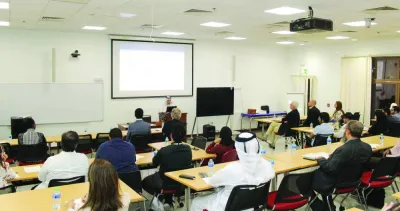Qatar is an ideal market for a telecom strategy to move subscribers on to Long Term Evolution (LTE), a 4G mobile communications standard, given the country’s high consumer spending power, according to Amy Cameron, head of ICT Research at BMI.
“Over the last two years Qatar's mobile market has shown impressive resilience despite the high penetration rate, which leads us to believe there remains room for more subscriptions growth over the coming years,” Cameron said in an interview to Gulf Times.
BMI Research, a Fitch Group company, believes a lot of this growth is driven by multiple device ownership such as smartphones and tablets. So if operators are successful in moving customers on to post-paid plans with shared data packages, it could pose a "downside risk" to subscription growth, but would put operators in a "stronger position" to retain existing customers and "upsell" them new services.
This latter trend — 'upselling' more advanced services, or 'premiumisation', which includes moving subscribers on to LTE, offering shared data plans on multiple devices such as tablets or cars and smart home services — offers the strongest opportunity for long term growth in BMI’s view, with Qatar being an ideal market for this strategy given high consumer spending power, Cameron said.
The same applies to BMI’s outlook for Qatar’s broadband market, she points out. While she expects some subscriptions growth, greater value lies in attracting customers on to bundled services and fibre connections — Ooredoo's triple play revenues were up 16.2% y-o-y in 2015, and Internet revenues were up 12.5%, likely driven by strong growth in fibre subscriptions.
Asked what impact 5G launch would have on Qatar’s wireless broadband technology, Cameron said, “I expect that a commercial 5G launch will cannibalise existing 3G and 4G subscribers, resulting in a similar pattern to what is occurring now between 3G/4G and 2G subscriptions, with the number of 3G/4G subscriptions having surpassed the number of 2G subscriptions in Qatar in 2013, by our estimates.
“Exactly what the breakdown between 2G/3G/4G/5G will look like is impossible to say yet, as it remains unclear, which spectrum will be necessary for 5G (and therefore whether/which older networks' spectrum could be refarmed). However, we expect any remaining 2G subscribers to continue to migrate to more advanced technologies, offsetting the 3G/4G losses to 5G.”
On the fixed broadband segment in Qatar, Cameron said Vodafone had been “unable to challenge” Ooredoo in the wireline segment thus far.
“Given there remains limited room for net subscriptions growth, it is unlikely that Vodafone will be able to counter Ooredoo's dominance over the short to medium term. However, Vodafone can leverage its parent's extensive experience in M2M and the ‘Internet of Things’ to capture new opportunities in these areas.
“Over the longer term, particularly when 5G becomes commercially available resulting in ever more powerful mobile networks, we expect the focus to shift from networks (mobile or wireline) to services. This would help to strengthen Vodafone Qatar's competitive position, given that it will be able to leverage a sophisticated range of services developed by Vodafone Group,” Cameron said.
Competition, she said would “continue to force down” price per GB of data and both operators' mobile average revenue per user (ARPUs).
“Our view — globally, not just for Qatar — is that telecoms operators must mitigate ARPU decline by migrating customers to premium services. This includes moving customers to higher value services (2G to 3G/4G, ADSL to fibre, single service to bundled multi-play packages), as well as launching entirely new services such as connected cars (AT&T is doing particularly well in this strategy) and connected homes,” Cameron said.
Highlighting telecom as a key sector in Qatar’s economic diversification efforts, Cameron said Qatar's government had shown strong support and encouragement for the development of smart cities and adoption of more advanced technologies among business and consumers, so that is a good starting point.
Adoption of advanced IT services such as cloud computing and big data analytics remains quite low according to ictQATAR's latest report. It suggests there is strong room for growth.
Meanwhile, use of social media, e-commerce and other online services are also on the rise, requiring ongoing investment in advanced IT solutions and supporting networks.
“However, Qatar is limited by its small population size, and a small local IT services market (in terms of developing IT services to sell locally and export). So yes, we think ICT can help drive the non-oil sector, but building a vibrant local IT services sector will be difficult with a small population,” Cameron opined.

BMI Research believes growth is driven by multiple device ownership such as smartphones and tablets.



